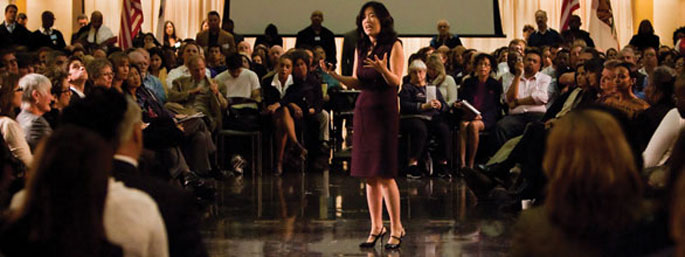The gleeful response from Michelle Rhee’s critics to the news that she would be stepping down from her role as CEO of StudentsFirst was predictable, even if it said more about them than her. After all, she took strong positions on controversial issues, clashed with some of the nation’s most prominent union leaders, and triggered major policy shifts in New York City, Washington D.C. and elsewhere. She disdained niceties in a field that prefers to soft-pedal things. So it was no surprise to see groups like the United Federation of Teachers tweet “good riddance.”
Since then, there’s been a rush to write Michelle’s education reform epitaph. While some observers have been admirably nuanced in their characterizations, most have only further disfigured an already caricatured portrait. “She leaves a trail of disappointment and disillusionment,” assessed Politico. “Education’s Ann Coulter,” sneered Salon.com.
Having worked closely with Michelle for years during her time at TNTP, I know she was never afraid to be a lightning rod and took on the role willingly. Always true to her convictions, she put the interests of students before even her own reputation.
The question is, should she have had to do so? Did she earn the tar-and-feathers treatment?
Some would surely say yes. Under her watch, D.C. Public Schools dismissed an unprecedented number of teachers for performance reasons. When she was Chancellor, nobody forced her to pose with a broom on the cover of TIME magazine—an image that defined her to a greater degree than anything else before or since. Not only that, but in starting StudentsFirst, she explicitly presented herself as an antagonist to the teachers unions. She titled her own book about her experiences Radical. In making herself a combative public figure, her critics would claim, she warranted attack and earned every insult.
And yet, it’s hard to argue that she gave as good as she got. When the American Federation of Teachers covertly put up RheeFirst, a brass-knuckles website featuring a crudely doctored photo of Michelle wearing a tiara and jabs at her family and motives, she could have reciprocated with a site bashing AFT President Randi Weingarten. She didn’t. Despite enduring insults about her ethnicity, her teaching experience and her integrity, she never responded in kind. She may have been blunt, but she never got personal.
Michelle shaped the reputation she now has, there’s no doubt about that. But she’s been made a cartoon by her critics, and I find that two-dimensional version hard to square with the woman I know and the simple reality of her achievements.
Consider what she’s done in her professional career: She built this organization, which not only grew significantly under her leadership but tripled in size after she left. She helped turn D.C. Public Schools from a district in a death spiral into one of the nation’s fastest-improving school systems. And she founded StudentsFirst, which may not have reached the stratospheric goals she originally set, but has built a strong network of state affiliates and is hardly done yet. If this is what a trail of disappointment looks like, we should all hope to walk it.
We say we want change. Stronger, more consistent schools. Higher standards. A more prestigious teaching profession. More efficient and responsive public education bureaucracies. We can argue about the best way to achieve those goals. But to reach them, we need people like Michelle (or Cami Anderson, or John King, or…), who ask hard questions and sometimes do upsetting things. Without them, inertia prevails.
Should good intentions exempt such leaders from criticism? Of course not. It’s fair to disagree with their policy stances, strategies and decisions, just as it’s fair to debate their effectiveness after the fact. The only thing we gain from making them monsters, though, is a more polarized and toxic environment that discourages leaders of any stripe from making difficult decisions around the real issues.
The politics of personal destruction is nothing new. It is often lamented but also time-honored in its effectiveness. Stopping change by attacking the person leading it is precisely the point. But that is easier to do when leaders stand alone.
In the end, Michelle’s critics weren’t demonizing her because they were horrible people. They did it because she was repeatedly effective at challenging them on issues that had previously been suppressed. She went there and did not apologize for it. Now, as this summer’s Vergara verdict showed, there will be no putting the genie back in the bottle on the question of the importance of excellence in teaching.
Michelle Rhee stood alone more often than most. Her critics deserve shame for being so quick to paint her as the wicked witch. And the rest of us earned some shame for letting them get away with it a lot of the time. But in the long view, a sophomoric website or a few racist comments won’t obscure what Michelle has accomplished. And hopefully we can learn from her experiences and ensure that the next generation of leaders who raise bold questions don’t stand alone.








